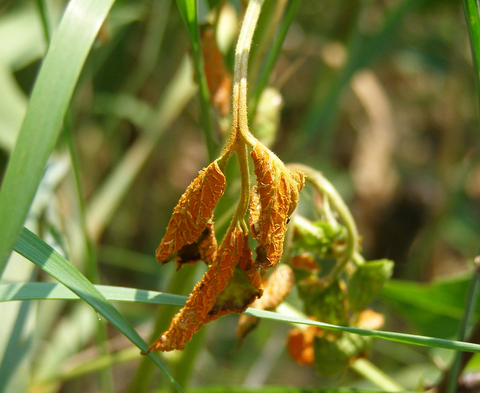Quick facts
- Orange rust is a serious disease of black raspberries and blackberries that is caused by two closely related fungi.
- Orange rust does not infect red raspberries.
- Although uncommon in Minnesota, orange rust can cause serious damage when it does happen.
- The plants survive but black raspberry plants with orange rust don’t produce flowers or fruit.
- To manage this disease, plants with orange rust should be dug up or killed.
See Growing raspberries in the home garden for more information on keeping plants healthy.
How to identify orange rust
Orange rust on raspberry leaf Orange rust is easy to identify in the spring on young black raspberry shoots.
- When black raspberry canes sprout in the spring, infected shoots are weak and thin with small, pale green or yellowish leaves.
- After 2 or 3 weeks, the fungus makes cushion-like, spore-producing structures on the lower surface of the leaf.
- At first, the structures are pale orange and waxy.
- Then, the structures break open and release bright orange powdery spores.
- After the fungal spores are released, the infected leaves fall off and the primocanes (first year cane) will often grow normally.
See Growing raspberries in the home garden for more information on keeping plants healthy.
How does orange rust survive and spread?
- Arthuriomyces peckianus is the rust fungus that infects black raspberries while Gymnoconia nitens infects blackberries and dewberries.
- Orange rust is one of the few fungal diseases that spreads internally throughout the entire plant, from the roots to the canes.
- Once a plant is infected, all the canes produced by that plant will always have the disease.
- The fungus survives the winter within the infected crown.
- Spores are produced on weak primocanes in early spring or late summer.
- Spores move by wind to new plants.
- Mature leaves are more likely to be infected than young growing leaves.
- Leaves must be wet for many hours for spores to start a new infection.
- The disease spreads from the leaves to the stems and roots.
How to manage orange rust
Since orange rust can’t be cured, plants infected with orange rust should be dug up or killed.
- Examine black raspberry and blackberry plants in early spring, when the new primocanes are less than a foot high.
- At the same time look for any wild black raspberries that may be near the garden.
- Any plants with weak, thin shoots and pale yellow or green leaves should be dug up and composted or killed with herbicide.
- Always remove or kill infected plants in early spring before the new canes release powdery, orange spores.
Reviewed in 2024


